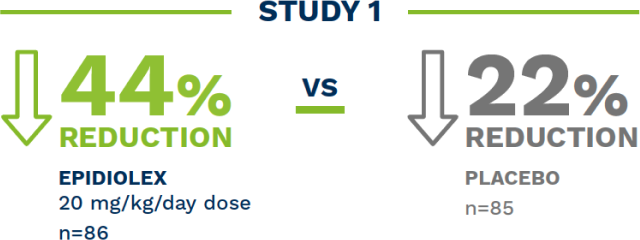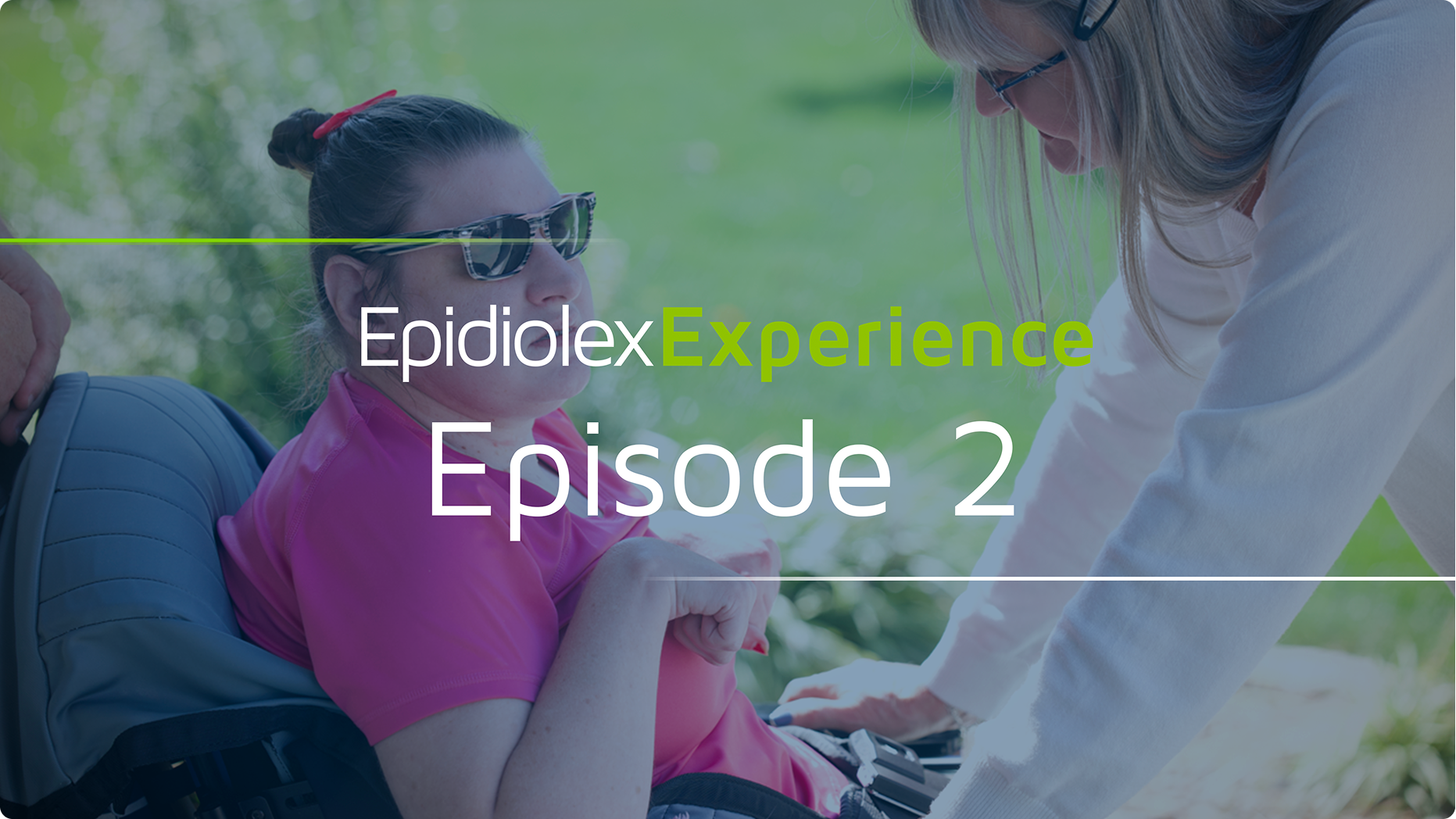Case study: 32-year-old male continues to experience uncontrolled seizures despite treatment
Past medical history
Seizure onset:
Began experiencing seizures around birth
Seizure types:
Affected by drop, myoclonic, and generalized seizures
Seizure frequency:
Experiences 1 to 2 drop and generalized seizures a month, and daily myoclonic seizures (up to 20 per day)
EEG features:
Slow, disorganized, paroxysmal delta features
Other:
Developmental delay, behavioral disorder with self-injurious behavior
Treatment history
Past Treatments
Current treatment regimen
- Valproate
- Clobazam
- Lamotrigine
- Topiramate
- Levetiracetam
- Vigabatrin
- Stiripentol
- Fenfluramine
- Lacosamide
- 20 mg clobazam BID (twice a day)
- 300 mg lamotrigine BID
- 200 mg lacosamide BID
Treatment history
Past Treatments
- Valproate
- Clobazam
- Lamotrigine
- Topiramate
- Levetiracetam
- Vigabatrin
- Stiripentol
- Fenfluramine
- Lacosamide
Current treatment regimen
- 20 mg clobazam BID (twice a day)
- 300 mg lamotrigine BID
- 200 mg lacosamide BID
Diagnosing the patient with LGS
Several clinical criteria (EEG features, history of multiple seizures, developmental delays/behavioral disorder) supported a diagnosis of LGS.
“Even though pediatric neurologists may be more used to dealing with LGS, this diagnosis doesn’t have to be difficult for those of us treating adult patients. In this case, the combination of multiple seizure types, abnormal EEG, history of developmental delay, and extensive ASM treatment history all pointed to LGS.”
— Daniel Mattson, MD, MSc
Adding EPIDIOLEX to the patient’s treatment regimen
“For this patient, a change to his treatment regimen was clearly needed. EPIDIOLEX was an appropriate choice, as it is broadly indicated for the seizure types associated with LGS, several of which this patient had been experiencing.”
— Daniel Mattson, MD, MSc
- Patient was started on 5 mg/kg/day (2.5 mg/kg BID) of EPIDIOLEX, which was then increased to 20 mg/kg/day over the course of 6 weeks
- Due to the potential for increased somnolence in patients taking EPIDIOLEX and concomitant clobazam, the patient’s clobazam dosage was decreased to 10 mg BID
- The patient underwent liver function tests, which were found to be normal:
- Aspartate transaminase (ASTs): 36
- Alanine transaminase (ALTs): 38
- Bilirubin: 1.1
There is a bidirectional pharmacokinetic interaction between EPIDIOLEX and clobazam in which each compound selectively increases exposure to the major active metabolite of the other without affecting parent drug levels.
Somnolence and sedation
Incidence of somnolence and sedation
In patients treated with EPIDIOLEX, somnolence and sedation were typically observed earlier in treatment and may diminish over time with continued treatment
LGS & Dravet syndrome clinical trials
Overall
Placebo (overall)
11%
EPIDIOLEX (overall)
32%
By dose
EPIDIOLEX (10 mg/kg/day)
27%
EPIDIOLEX (20 mg/kg/day)
34%
Use of clobazam
EPIDIOLEX (without clobazam)
16%
EPIDIOLEX (with concomitant clobazam)
46%
- Somnolence and sedation generally occur early in treatment and may diminish with continued treatment. These effects were more common in patients on concomitant clobazam
- Pneumonia was observed more frequently with concomitant use of EPIDIOLEX and clobazam
- Elevated ammonia levels have been reported in some EPIDIOLEX-treated patients who also had transaminase elevations. Most cases reported concomitant use of valproate, clobazam, or both
- Consider a reduction of dosage or discontinuation of clobazam if known clobazam adverse reactions occur
- Other CNS depressants, including alcohol, could potentiate the somnolence and sedation effect of EPIDIOLEX
- Monitor for somnolence and sedation and advise patients not to drive or operate machinery until they have gained sufficient experience on EPIDIOLEX
Concomitant clobazam
Like this patient, 49% of patients in the LGS clinical trials were on concomitant clobazam. 22% of patients in the LGS studies taking concomitant clobazam with either dose of EPIDIOLEX reported a dose reduction of clobazam during the trial.
“EPIDIOLEX and clobazam can be effective treatment partners for patients with LGS. When starting this patient on EPIDIOLEX, I reduced his clobazam dosage to address side effects. I also spoke to his family about the possibility of somnolence, so they were aware of what to expect.”
— Daniel Mattson, MD, MSc
Explore further
For more information about the therapeutic relationship between clobazam and EPIDIOLEX, watch A Potential Treatment Partnership for LGS.
In the LGS clinical trials, EPIDIOLEX significantly reduced frequency of drop and total seizures
Median percent reduction in monthly frequency of drop seizures


Additionally, in the LGS clinical trials, patients taking EPIDIOLEX 20 mg/kg/day experienced a 41% (Study 1) and 38% (Study 2) median percent reduction in monthly frequency of total seizures, and patients taking EPIDIOLEX 10 mg/kg/day experienced a 36% (Study 2) reduction, compared to 14% (Study 1) and 18% (Study 2) reduction for patients taking placebo. Total seizures were defined as drop and non-drop seizures.
Adverse events
Most common adverse events
Most common adverse events (≥10% and greater than placebo) observed during the 14-week treatment period of Phase 3 controlled trials for LGS and Dravet syndrome (%)
| Placebo (n=227) | EPIDIOLEX 10 mg/kg/day (n=75) | EPIDIOLEX 20 mg/kg/day (n=238) | ||
|---|---|---|---|---|
| Hepatic disorders | ||||
| Transaminases elevated | 3 | 8 | 16 | |
| Gastrointestinal disorders | ||||
| Decreased appetite | 5 | 16 | 22 | |
| Diarrhea | 9 | 9 | 20 | |
| Nervous system disorders | ||||
| Somnolence | 8 | 23 | 25 | |
| Fatigue, malaise, asthenia | 4 | 11 | 12 | |
| Insomnia, sleep disorder, poor-quality sleep | 4 | 11 | 5 | |
| Infections | ||||
| Infection, all | 31 | 41 | 40 | |
| Other | ||||
| Rash | 3 | 7 | 13 |
| Hepatic disorders | ||
|---|---|---|
| Transaminases elevated | ||
| Placebo (n=227) | EPIDIOLEX 10 mg/kg/day (n=75) | EPIDIOLEX 20 mg/kg/day (n=238) |
| 3 | 8 | 16 |
| Gastrointestinal disorders | ||
| Decreased appetite | ||
| Placebo (n=227) | EPIDIOLEX 10 mg/kg/day (n=75) | EPIDIOLEX 20 mg/kg/day (n=238) |
| 5 | 16 | 22 |
| Diarrhea | ||
| Placebo (n=227) | EPIDIOLEX 10 mg/kg/day (n=75) | EPIDIOLEX 20 mg/kg/day (n=238) |
| 9 | 9 | 20 |
| Nervous system disorders | ||
| Somnolence | ||
| Placebo (n=227) | EPIDIOLEX 10 mg/kg/day (n=75) | EPIDIOLEX 20 mg/kg/day (n=238) |
| 8 | 23 | 25 |
| Fatigue, malaise, asthenia | ||
| Placebo (n=227) | EPIDIOLEX 10 mg/kg/day (n=75) | EPIDIOLEX 20 mg/kg/day (n=238) |
| 4 | 11 | 12 |
| Insomnia, sleep disorder, poor-quality sleep | ||
| Placebo (n=227) | EPIDIOLEX 10 mg/kg/day (n=75) | EPIDIOLEX 20 mg/kg/day (n=238) |
| 4 | 11 | 5 |
| Infections | ||
| Infection, all | ||
| Placebo (n=227) | EPIDIOLEX 10 mg/kg/day (n=75) | EPIDIOLEX 20 mg/kg/day (n=238) |
| 31 | 41 | 40 |
| Other | ||
| Rash | ||
| Placebo (n=227) | EPIDIOLEX 10 mg/kg/day (n=75) | EPIDIOLEX 20 mg/kg/day (n=238) |
| 3 | 7 | 13 |
Ongoing liver monitoring
Ongoing liver monitoring is recommended as EPIDIOLEX can cause dose-related elevations of liver transaminases.
Incidence of ALT elevations >3x the ULN in patients with LGS and Dravet syndrome tested with EPIDIOLEX
LGS and Dravet syndrome clinical trials
EPIDIOLEX + clobazam and valproate
EPIDIOLEX + valproate (without clobazam)
EPIDIOLEX + clobazam (without valproate)
EPIDIOLEX (without clobazam or valproate)
30%
21%
4%
3%
EPIDIOLEX + clobazam and valproate
LGS and Dravet syndrome clinical trials
30%
Treatment
EPIDIOLEX + valproate (without clobazam)
LGS and Dravet syndrome clinical trials
21%
Treatment
EPIDIOLEX + clobazam (without valproate)
LGS and Dravet syndrome clinical trials
4%
Treatment
EPIDIOLEX (without clobazam or valproate)
LGS and Dravet syndrome clinical trials
3%
Elevations in overall population of patients with LGS, Dravet syndrome, and TSC
Elevations resolved in 2/3 of patients following:
- Discontinuation of EPIDIOLEX, or
- Reduction of EPIDIOLEX and/or concomitant valproate
And in 1/3 of patients:
- With no change in EPIDIOLEX treatment
Elevations typically occurred within the first 2 months of treatment; however, there were some cases observed up to 18 months after initiation.
- There were cases of transaminase elevations associated with hospitalization
Risk factors for elevated transaminases include:
- Increased EPIDIOLEX dose
- Concomitant use of valproate and, to a lesser extent, clobazam
- Baseline transaminase elevations
Less than 1% of EPIDIOLEX patients had ALT or AST >20x the ULN.
Obtain serum transaminases (ALT and AST) and total bilirubin levels
- Prior to starting treatment with EPIDIOLEX, obtain serum transaminases (ALT and AST) and total bilirubin levels
- Serum transaminases and total bilirubin levels should be obtained at 1 month, 3 months, and 6 months after initiation of treatment with EPIDIOLEX, and periodically thereafter or as clinically indicated
- Consider more frequent monitoring of serum transaminases and bilirubin in patients who are taking valproate or who have elevated liver enzymes at baseline
- Monitor within 1 month following changes in EPIDIOLEX dosage and addition of or changes in medications that are known to impact the liver
- Consider discontinuation or dose reduction of EPIDIOLEX or concomitant medications known to affect the liver (eg, valproate or clobazam) if liver enzyme elevations occur (transaminase levels >3x the ULN and bilirubin levels >2x the ULN, or sustained transaminase elevations >5x the ULN)
Patient experienced reduction in seizures on EPIDIOLEX
As of January 2023:
- Patient continues to take 20 mg/kg/day (10 mg/kg BID) of EPIDIOLEX
- Like many patients in the LGS clinical trials, this patient’s seizure frequency significantly reduced after treatment with EPIDIOLEX. This patient’s drop seizures and convulsive activity has reduced to just one per month, and the frequency of his myoclonic seizures has reduced significantly
- Continual liver monitoring is ongoing for this patient and has so far yielded normal results
- In addition to significant seizure reduction, the patient has experienced an increase in his appetite since his seizures have reduced
Case study summary
“I like to emphasize that epilepsy treatment is a marathon, not a sprint. Like my patient, other adult patients may benefit from a slower approach to EPIDIOLEX titration that can help manage side effects while maximizing benefits to seizure reduction. EPIDIOLEX was both effective and well tolerated for this patient, resulting in a significant reduction in his seizure burden.”
— Daniel Mattson, MD, MSc
Want to explore more on LGS?






